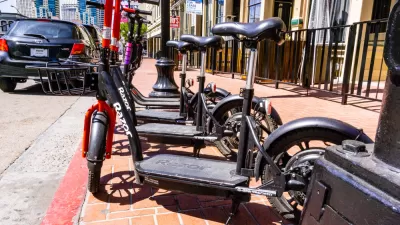Planners and designers should not be afraid to reclaim overused and misused words—as long as they know what they're doing.

The other day I got into a bit of a spat on Twitter with someone who had clearly had enough with the word "activate."
"Activate may be the worst planning jargon yet," cried the initial tweet.
A second tweet followed: "Seriously, students of planning, do yourselves a favor. Don't ever tell people you're activating their space."
That got me thinking about the years I spent working as the outreach coordinator for the College of Environmental Design at Cal Poly Pomona. While I was there, a group of students, representing the departments of Urban and Regional Planning, Landscape Architecture, Architecture, and Art, formed a club called the Space Activators.
In their spare time, the Space Activators dreamed up new ways to enjoy locations around campus. Some of these locations suffered the neglect of underuse, while others suffered the other kind of neglect that comes from overuse. The Space Activators created large works of public art by dragging and chalking a large expanse of gravel, exposing pattern and color to the upper floors of the nearby campus administration building. They threw Frisbees on vast, empty plots of grass. They inflated a 400-foot-long solar bag in the college's main public commons. They created a Facebook page to share ideas about how to activate off-campus spaces. In other words, they actively activated spaces.
Inspired by their work, and the concepts I learned from them, I found myself looking to other parts of campus, and other places I encountered in my life, with a new understanding of what makes them successful, fun, appreciated, and valuable. I also began to recognize, far too frequently, many places that were just the opposite.
I can't imagine telling those students to change the name of their organization because they'd used a "dirty word"—especially since they had done such a good job exemplifying and illustrating their concept.
The tweeted dissent toward the word "activate" exemplifies a reactionary tendency among people frustrated, understandably, with the conversation about planning, community, and design. I've also seen tweets prohibiting any use whatsoever of the passive voice as well as the use of the word "vibrant," which seems to be the world's favorite word to hate. There is clearly a lot of room for improvement in how we conduct these discussions about the future of the places where we live, work, and play. But think of such prohibitions as the dark side of the Force: quicker, easier, more seductive. They are also misleading and wrong.
That's not to say that planners are innocent of one of the great sins of language: employing empty phrases, inflated with self-importance and multiple syllables. Yes, buzzwords and cheap tricks of syntax like the passive voice are often the vessel for this sin. But don't blame the language for the proclivities of humans.
I am frequently reminded of advice shared by one of my favorite instructors from my own time as an undergraduate: "You can write anything you want, if it works." At the time, I knew this teacher was attempting to empower a room full of timid young writers, but now I invoke this advice as a sort of incantation against linguistic fear mongering. I can use "activate," if it works.
"Activate" automatically gets a head start because it's a verb, and verbs provide the driving power of language (my advice for improving communications always begins with better attention to verbs). Activate is also a commonly used verb, with a commonly understood meaning. "Activate" did not start its life in the language as jargon.
Activate, like so many other words used by planners, does not work when it's used as a substitute for unplanned or unconsidered specifics—when it's really just code for "I didn't do the work" or "I can't really say." It's not the fault of the word "activate" if someone didn't do the work or has chosen not to speak openly and honestly.
But when it's used to support specific examples, creative ideas, and honest dialogue, the word "activate" becomes code for something much larger and more powerful. The word activate becomes a project—an ambitious and diverse project, requiring collective and individual effort.
At this point, I have focused too much on one word, which by itself is not of life-or-death concern to the field of planning. The process by which planners choose their words, however, can make or break a project—large or small.
Planners (and many other political animals, for that matter) have perverted a large number of otherwise reliable and useful words by employing them as empty tools of misdirection. Vibrant, sustainable, walkable, mobility, engagement, and creatives come to mind. By all means, expect more from planners and politicians when they use words like these for the sake of appearances, rather than to describe a carefully considered plan.
But avoiding a word altogether also avoids the process of deciding why, when, and how it works. Knowing why, when, and how something works requires creative thought and careful evaluation. It requires planning.

Alabama: Trump Terminates Settlements for Black Communities Harmed By Raw Sewage
Trump deemed the landmark civil rights agreement “illegal DEI and environmental justice policy.”

Planetizen Federal Action Tracker
A weekly monitor of how Trump’s orders and actions are impacting planners and planning in America.

The 120 Year Old Tiny Home Villages That Sheltered San Francisco’s Earthquake Refugees
More than a century ago, San Francisco mobilized to house thousands of residents displaced by the 1906 earthquake. Could their strategy offer a model for the present?

In Both Crashes and Crime, Public Transportation is Far Safer than Driving
Contrary to popular assumptions, public transportation has far lower crash and crime rates than automobile travel. For safer communities, improve and encourage transit travel.

Report: Zoning Reforms Should Complement Nashville’s Ambitious Transit Plan
Without reform, restrictive zoning codes will limit the impact of the city’s planned transit expansion and could exclude some of the residents who depend on transit the most.

Judge Orders Release of Frozen IRA, IIJA Funding
The decision is a victory for environmental groups who charged that freezing funds for critical infrastructure and disaster response programs caused “real and irreparable harm” to communities.
Urban Design for Planners 1: Software Tools
This six-course series explores essential urban design concepts using open source software and equips planners with the tools they need to participate fully in the urban design process.
Planning for Universal Design
Learn the tools for implementing Universal Design in planning regulations.
Clanton & Associates, Inc.
Jessamine County Fiscal Court
Institute for Housing and Urban Development Studies (IHS)
City of Grandview
Harvard GSD Executive Education
Toledo-Lucas County Plan Commissions
Salt Lake City
NYU Wagner Graduate School of Public Service





























